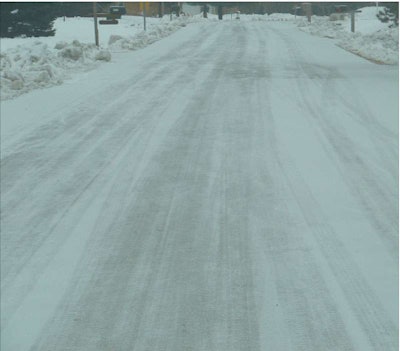Balancing Act: snow and ice free roads/environmental responsibility
By Tina Grady Barbaccia

It’s no secret that salt and chemicals aren’t great for the environment, but agencies need to keep roads open and safe for the motoring public. So how do you develop a green plan for the white stuff with a focus on sustainability and environmental responsibility? How do you account for your actions and the reactions that will occur?

For example, in Minnesota, the large number of lakes had to be taken into consideration when developing a winter maintenance sustainability plan. The Minnesota Department of Transportation (MinnDOT) discovered the state was having high levels of concentrate of chloride in the water. Once some bridges were deemed as “chloride-free” bridges – sodium acetate was used instead – the pH levels of the water dropped.
Right Place, Right Time
The key is using salt and chemicals at the “right place, at the right time, for the right reason,” Scharffbillig says. This means an agency doesn’t just wait until a snow or ice event has occurred and then goes out and salts the highways and bridges. It also means a well thought-out plan that uses current weather and equipment technologies, and special needs of the geographic location must be considered. When Better Roads spoke to Scharffbillig the day before Thanksgiving, Minneapolis had been sacked with snow and it was gearing up to deal with another major snow and ice event and the heavy traffic and travel associated with the holiday.
“The state was out … pre-treating with anti-icing agents,” Scharffbillig points out. This illustrates good sustainability practices so salt and chemicals weren’t overapplied. By pretreating, less salt was necessary and it worked more effectively, Scharffbillig notes.
Smart Snow, Ice Removal
To further reduce impact on the environment, Scharffbillig says, MinnDOT and the City of Minneapolis are using smart controllers. These are electronic devices that allow equipment to be precalibrated for the amount of granule or liquid material being applied. “It’s not 100 percent accurate, but is a lot more so than manual controllers,” Scharffbillig points out. Some of the smart controllers actually send back the application rate to the people in the dispatch center, so they know whether the rate is set at 40 pounds or 20 gallons per lane mile.
“You need to look at everything, You can’t just say you need to reduce salt. You have to look at the total picture and come up with the best methodology for your area.”
— John Scharffbillig, director of public works fleet services for the City of Minneapolis
With GPS becoming more robust, plow operators can now just drive through gates or simply use a flash drive to get application information that has been written to a PCIM card.
Over-application or not having a carefully calculated plan for applying liquids and salt or salt brine is one of the biggest problems with sustainability issues, Scharffbillig says. However, by analyzing the data, agencies can determine how much material was applied, when, and under what conditions. Not only can application rates be adjusted, but snowplow operators can also be trained to deal with specific areas in various conditions.
 Using anti-icing agents can help reduce the amount of salt and other deicing chemicals used to treat bridges and roads.
Using anti-icing agents can help reduce the amount of salt and other deicing chemicals used to treat bridges and roads.On a freeway, material should be applied in a narrow band. “You can put it on the crown of the road so the traffic carries it off,” Scharffbillig says. “You want a very narrow bandwidth.”
However, in a city environment where speeds are lower, the application approach must be altered. “The real key here is driver speed,” Scharffbillig says. “You want to go slower, and the patterns are a little wider at intersections. Even if you are pre-wetting the salt, it still bounces off and goes down the side of the road, so operators need to slow down their speeds. The optimum speed is between 15 to 25 miles per hour.”
GPS or smart controller units that collect speed and application rates are often used now to help operators adhere to these sensible salting guidelines.
“These aren’t your grandpa’s snowplows,” Scharffbillig says. “You can’t go by the thinking that, ‘If a little [salt or chemical] is good, a lot is better,’” Scharffbillig says. “More is not necessarily better. If you apply too many chemicals, it can actually cause more problems. You are only as good as the person behind the wheel. If the people actually operating the trucks know what the end goal is, they are very willing to produce this. They just want to do the best job out there and get their families home safe. They want to get home just like everyone else. The real key is with the person removing the snow. They need to know what the ultimate goal is.”
The issue is that the chemicals have a very particular purpose to either prevent or break the bond between the snow and ice and the road surface, explains Wilf Nixon, P.E., Ph.D., professor of civil and environmental engineering at the University of Iowa.
“There is the misconception that the chemical is there to burn off the snow,” Nixon notes. “If you are trying to burn off the snow, you’d need a whole lot more chemical and it’s not the right way of getting the job done. The snowplow operator is usually very concerned about making sure the roads they are responsible for are in the best possible shape.”
The motivation for this could be several things – the safety of their own family members or just pride in their work.
“But the primary driving factors why they are doing their work can sometimes lead them to be overenthusiastic,” Nixon points out. “When they use chemicals, they may think that if some is good a whole lot more might be better.”
This is of course, just not so.v
Next month: Sensible Salting and the Latest Winter Technologies










